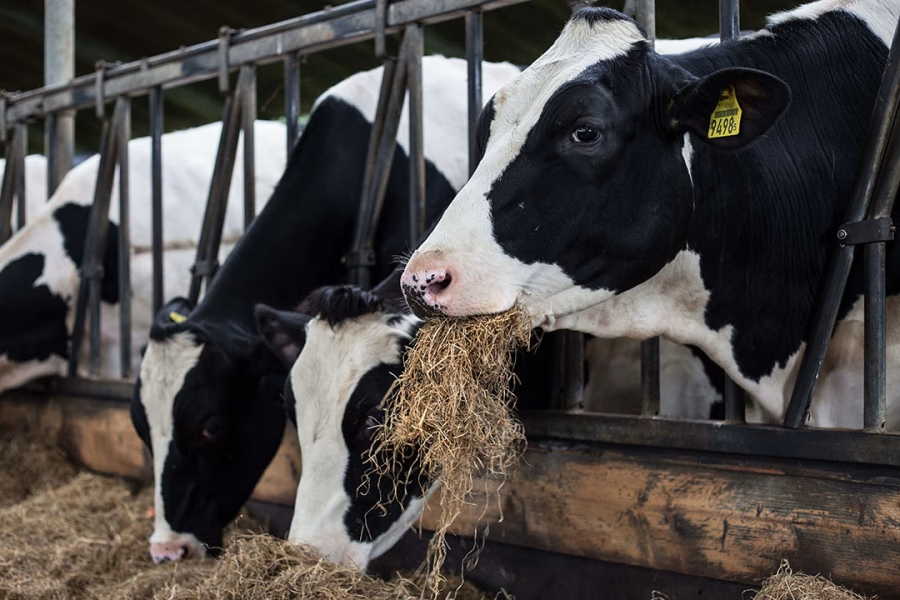Learn how genomic testing is improving the profitability of the UK’s dairy herds. Are you using genetic insights to enhance your farm’s profits? Find out more.

Imagine a future where the United Kingdom’s dairy farms keep pace with global competitors and lead in efficiency and profitability. This potential is swiftly becoming a reality thanks to advancements in genomic testing of dairy heifers.
The latest analysis from the Agriculture and Horticulture Development Board (AHDB) underscores the significant financial benefits of genomic testing. It reveals a substantial gap in the Profitable Lifetime Index (£PLI) between herds engaging in genomic testing and those not. This article delves into the financial impact of genomic testing for the UK’s dairy herd, highlighting its potential to boost profitability and sustainability significantly. Improving genetics through genomic testing is a cost-effective and sustainable way to make long-term improvements to any herd.
Genomic testing is revolutionizing dairy farming. It is a powerful tool for enhancing herd profitability and sustainability. We’ll examine the statistical evidence of PLI differences, theoretical and actual financial benefits, and the significant rise in genomic testing of dairy heifers. Additionally, we’ll address the issue of misidentified animals and the breeding implications.
Genomic testing has dramatically shaped the industry since its introduction to UK producers. This transformative approach boosts farm profitability and ensures long-term sustainability. By leveraging genomic testing, dairy producers can make informed decisions that profoundly impact their operations and the broader agricultural economy.
Genomic Testing Revolutionizes Genetic Merit of UK Dairy Herds: AHDB Reveals Significant PLI Disparity with Profound Implications for Productivity and Profitability
Genomic testing is revolutionizing the genetic merit of the UK’s dairy herd, significantly boosting productivity and profitability. The Agriculture and Horticulture Development Board (AHDB) reports a £193 gap in the average Profitable Lifetime Index (£PLI) between herds heavily engaged in genomic testing and those less involved.
Producers testing 75-100% of their heifers have an average £PLI of £430 for their 2023 calves, compared to £237 for those testing 0-25%. This stark difference underscores the critical role genomic testing plays in improving the genetic quality of dairy cattle. It enhances health, longevity, and productivity, making it a powerful tool for herd management and breeding strategies.
This £193 PLI difference translates to an estimated £19,300 profit potential for a 175-head herd. However, real-world accounts show the benefits can exceed £50,000. This underscores the significant financial rewards that genomic testing can bring, making it a vital tool for informed breeding decisions that drive long-term economic and genetic gains.
Potential Gains and Real-World Financial Impact of Comprehensive Genomic Testing in Dairy Herds
Genomic testing offers a compelling route to profitability for dairy producers. Herds genotyping 75-100% of their heifers achieve an average £430 PLI, while those testing only 0-25% lag at £237.
This gap translates into significant gains. A 175-head herd could theoretically gain £19,300. However, real-world data suggests that the financial advantage can exceed £50,000, highlighting the profound impact of genomic testing on profitability.
Marco Winters Advocates Genomic Testing: A Cost-Effective and Sustainable Path to Long-Term Herd Improvement
Marco Winters, head of animal genetics for AHDB, underscores the cost-effectiveness and sustainability of improving herd genetics through comprehensive genomic testing. “Genetics is probably the cheapest and most sustainable way of making long-term improvements to any herd,” Winters notes. “And when it’s aimed at boosting profitability, the benefits directly impact a farm’s bottom line.”
Winters highlights that significant returns outweigh the initial investment in genomic testing. A 175-head herd can see theoretical profit gains of £19,300, but actual accounts show this figure can exceed £50,000.
Additionally, Winters emphasizes the sustainable nature of genomic testing. Enhancing herd health and productivity helps farmers avoid recurring costs associated with other improvement strategies, ensuring long-term viability and a competitive edge for UK dairy farms.
Precision Breeding Through Genomic Insights: Revolutionizing Herd Management and Breeding Strategies
As genomic testing gains traction, its implications for herd management are profound. With 20% of the recorded herd currently undergoing tests, which is expected to rise, dairy farmers recognize the potential within their livestock’s DNA. This shift highlights the industry’s evolution towards data-driven decision-making in animal husbandry, with genomic insights becoming a cornerstone of successful herd management strategies.
Genotyping not only clarifies lineage but also opens avenues for targeted genetic improvements. By identifying the exact genetic makeup of heifers, farmers can make informed decisions, enhancing traits such as milk production, health, and fertility. This precision breeding minimizes the risk of inbreeding. It ensures that the most viable and productive animals are chosen as replacements.
The financial benefits of genomic testing are evident. Benchmarking herds using tools like the AHDB’s Herd Genetic Report allows farmers to understand the impact of their genetic strategies on profitability. The industry benefits from increased efficiency and productivity as the national herd shifts toward higher genetic merits.
Genomic testing extends beyond Holstein Friesians to Channel Island breeds and Ayrshires, showing its broad applicability. This comprehensive approach to herd improvement underscores the AHDB’s commitment to leveraging cutting-edge biotechnologies to drive progress in dairy farming.
In conclusion, genomic testing is reshaping dairy farming in the UK. By embracing these technologies, farmers enhance the genetic potential of their herds, securing a more profitable and sustainable future. Genomic insights will remain a cornerstone of successful herd management strategies as the industry evolves.
Harnessing the AHDB’s Herd Genetic Report: A Strategic Blueprint for Elevating Genetic Potential and Ensuring Herd Sustainability
Farmers aiming to optimize their herd’s genetic potential should take full advantage of the AHDB’s Herd Genetic Report. This invaluable resource allows producers to benchmark their herd’s Profitable Lifetime Index (£PLI) against industry standards and peers. Farmers can gain critical insights into their herd’s genetic strengths and weaknesses, enabling more informed and strategic decisions regarding breeding and herd management. Accurately tracking and measuring genetic progress is essential for maintaining competitiveness and ensuring dairy operations’ long-term sustainability and profitability.
The Bottom Line
The transformative impact of genomic testing on the UK’s dairy herds is evident. Producers leveraging genotyping for heifers see remarkable gains in their Profitable Lifetime Index (£PLI), leading to significant financial rewards. This underscores the crucial role of genetic advancement, widening the gap between engaged and less engaged herds and inspiring a new era of progress in the industry.
Accurate breeding records become essential with rising genomic testing across various breeds and corrections of misidentified animals. Integrating genomic insights into herd management allows producers with better genetic information to achieve superior outcomes. AHDB’s analysis reveals a shift from a sole focus on milk production to a balanced focus on health, management, and fertility, setting a new standard for future strategies and ensuring the reliability of genomic testing.
Every dairy producer should utilize tools like the AHDB’s Herd Genetic Report to benchmark and enhance their herd’s genetic potential. Embracing genomic testing is an investment in long-term success, revolutionizing herd management for profitability and sustainability in a competitive dairy market.
Key Takeaways:
- Genomic testing significantly elevates the genetic merit of dairy herds, leading to more pronounced differences between the top-performing and bottom-performing herds.
- Producers who genotyped 75-100% of their dairy heifers achieved an average Profitable Lifetime Index (£PLI) of £430, while those testing only 0-25% had a PLI of £237.
- Improved genetics can translate to a theoretical value difference of approximately £19,300 for a typical 175-head herd, with actual margins showing an advantage exceeding £50,000.
- The uptick in genomic testing is notable, with around 100,000 dairy heifer calves tested, representing 20% of the recorded herd, expected to rise to 35% by year’s end.
- A significant number of animals have been misidentified, indicating potential inaccuracies in breeding strategies that could affect both quality and inbreeding rates.
Summary:
The UK’s Agriculture and Horticulture Development Board (AHDB) has identified a significant gap in the Profitable Lifetime Index (PLI) between herds engaged in genomic testing and those not. This highlights the financial benefits of genomic testing for the UK’s dairy herd, which can significantly boost profitability and sustainability. Improving genetics through genomic testing is a cost-effective and sustainable way to make long-term improvements to any herd. The £193 PLI difference translates to an estimated £19,300 profit potential for a 175-head herd, but real-world accounts show the benefits can exceed £50,000. Precision breeding through genomic insights is revolutionizing herd management and breeding strategies, with 20% of the recorded herd currently undergoing tests. Genotyping not only clarifies lineage but also opens avenues for targeted genetic improvements, enhancing traits such as milk production, health, and fertility.












